Journal of Advances in Physical Chemistry
Vol.
11
No.
04
(
2022
), Article ID:
57730
,
11
pages
10.12677/JAPC.2022.114021
过渡单分子磁体的研究进展
薛泓1,丁欣宇1,2*
1南通大学化学化工学院,江苏 南通
2南通智能与新能源材料重点实验室,江苏 南通
收稿日期:2022年8月8日;录用日期:2022年11月4日;发布日期:2022年11月11日

摘要
能在低温下展现磁弛豫行为的称为单分子磁体,单分子磁体在量子计算,高密度存储材料及分子自旋电子学方面具有广泛的应用前景,但目前对其的研究还处于理论研究阶段,距离实际应用仍有一定距离。近二十多年,研究者为了构筑高性能的单分子磁体合成了大量的配合物。本文结合现在研究成果,从不同过渡金属中心合成的配合物出发,对近年来各类单分子磁体的研究进展进行综述,旨在为设计合成高能垒的单分子磁体提供新思路。
关键词
单分子磁体,过渡,结构,磁性,有效能垒

Recent Advanced of Transition Single-Molecule Magnets
Hong Xue1, Xinyu Ding1,2*
1School of Chemistry and Chemical Engineering, Nantong University, Nantong Jiangsu
2Nantong Key Laboratory of Intelligent and New Energy Materials and Devices, Nantong Jiangsu
Received: Aug. 8th, 2022; accepted: Nov. 4th, 2022; published: Nov. 11th, 2022

ABSTRACT
Single-molecule magnets (SMMs) can show magnetic relaxation behavior at low temperatures, which have a wide range of application prospects in quantum computing, high-density storage materials and molecular spintronics, but their research is still in the theoretical research stage, and there is still a certain distance from practical application. For more than two decades, researchers have synthesized a large number of complexes in order to construct high-performance single-molecule magnets. Combined with the current research results, starting from the complexes synthesized by different transition metal centers, this paper reviews the research progress of various single-molecule magnets in recent years, aiming to provide new ideas for the design and synthesis of single-molecule magnets with high energy barriers.
Keywords:Single-Molecule Magnet, Transition, Structures, Magnetic Property, Effective Barrier

Copyright © 2022 by author(s) and Hans Publishers Inc.
This work is licensed under the Creative Commons Attribution International License (CC BY 4.0).
http://creativecommons.org/licenses/by/4.0/


1. 引言
1993年Sessoli等报道了{Mn12Ac}配合物 [1],该配合物在分子水平上表现出了缓慢的磁化现象,因此被认为是第一个单分子磁体,自此打开了研究单分子磁体的大门。这种真正意义上具有纳米尺寸的分子磁体在近年来得到飞速发展,一方面单分子磁体具有量子隧穿和量子干涉等效应,这对研究量子计算和分子自旋电子学有着巨大的帮助;另一方面单分子磁体有望突破传统磁体加工在尺寸上的限制,发出新型的超高密度存储材料 [2] [3] [4] [5]。单分子磁体的研究已逐渐成为材料、化学和物理研究的热点 [6]。
单分子磁体具有双稳态磁矩,能在低温下展现磁慢弛豫行为,单分子磁体的特性通常与高磁各向异性和高自旋量子数有关,其翻转能垒U是由体系的基态自旋值(S)和负的零场分裂能参数(D)共同决定的,关系式可表达为U = S2|D| (整数自旋)或(S2 − 1/4) |D| (分数自旋) [7]。因此为了合成高性能的单分子磁体,研究者们不断探索,设计合成了大量能表现磁弛豫行为的配合物,目前的研究大部分是针对3d过渡金属,特别是以Fe、Co、Mn、Ni等金属为中心构筑的单分子磁体,本文依次介绍了基于不同金属离子为中心的单分子磁体的研究进展。
2. 单分子磁体的发展
2.1. Mn原子构筑的单分子磁体
自从Sessoli报道了第一例{Mn12Ac}的单分子磁体以后,研究者希望继续合成出多核的金属配合物。试图用配合物的核数来提高分子的总自旋基态进而增加单分子磁体的磁性。在这些多核的配合物中含Mn的高核配合物居多,Christou等人 [8] [9] 合成了25核的Mn (II)和Mn (III)混合价态配合物[Mn25O18(OH)2(N3)12(pdm)6(pdmH)6]Cl2,配合物具有内分层对称的结构(图1),配合物的交流磁化率检测出其在虚部的信号在不同频率中存在信号分离现象,证明它可作为单分子磁体。其具有较大的基态自旋值为S = 51/2。
在同年,Tasiopoulos等人合成报道一种{Mn84}多核配合物 [10],该配合物的结构呈现一种相互重叠的石墨状(图2),通过阿伦尼乌斯关系拟合得出Ueff = 18 K,弛豫时间τ0 = 5.7 × 10−9秒。
然而,出人意料的是在单分子磁体研究的前十五年时间里,研究者们发现只有{Mn6}配合物 [11] 的能垒略高于最初的{Mn12}配合物(图3)。经过各个课题组一系列的研究发现,单分子磁体的有效能垒(Ueff = S2 |D|)和它的基态自旋值S并不是单纯的不呈线性的增长关系,相反如果追求大的基态自旋值S就会导致D值的下降。这一现象的发现使许多研究学者认识到单纯通过增加过渡金属配合物的核数来增加基态自旋值并不是合成高能垒单分子磁体的有效手段,表示应该从小分子或者从其他金属配合物入手研究单分子磁体合成策略,从而提高其有效能垒 [12] [13]。
 (a) (b)
(a) (b)
Figure 1. Centrosymmetric core of the cation of [Mn25O18(OH)2(N3)12(pdm)6(pdmH)6]Cl2 (a) and out-of-phase ac magnetic susceptibility ( ) vs. T for complex [Mn25O18(OH)2(N3)12(pdm)6(pdmH)6]Cl2 at the indicated ac frequencies (b)
图1. [Mn25O18(OH)2(N3)12(pdm)6(pdmH)6]Cl2阳离子的中心对称核(a)和在指定的交流频率下,[Mn25O18(OH)2(N3)12(pdm)6(pdmH)6]Cl2的虚部交流磁化率(b)
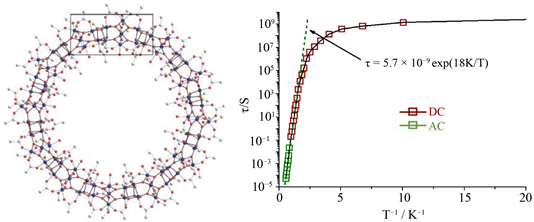 (a) (b)
(a) (b)
Figure 2. The structure of the {Mn84} torus, excluding hydrogen atoms (a), and Arrhenius plot constructed by using a combination of out-of-phaseAC susceptibility ( ) data and DC magnetization decay data (b)
图2.{Mn84}圆环的结构,不包括氢原子(a),通过使用虚部交流磁化率数据和直流磁化率拟合的伦尼乌斯图(b)
 (a) (b)
(a) (b)
Figure 3. The molecular structure of [MnIII6O2(Et-sao)6(O2CPh(Me)2)2(EtOH)6] (a) and Arrhenius plot using ac (green) and dc (red) data (b)
图3. [MnIII6O2(Et-sao)6(O2CPh(Me)2)2(EtOH)6]的结构式(a),和直流和交流下的阿伦尼乌斯图(b)
2.2. Fe原子构筑的单分子磁体
为了加深理解过渡单分子磁体的慢磁弛豫行为,研究学者们将眼光放到了简单的过渡金属上。J. R. Long团队 [14] 在2010年,报道出由二价铁构筑的过渡金属配合物K[(TPAMES)Fe] (H3tpaMes = Tris((5-mesityl-1H-pyrrol-2-yl)methyl)amine) (图4),配合物中的二价铁离子采用的配位几何构型是三角锥构型,利用这种配位方式使顺磁性离子的轨道角动量保存完整,磁性测试计算得到该配合物的有效能垒为42 cm−1。
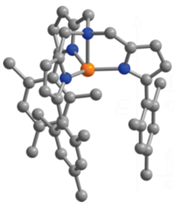
Figure 4. The molecular structure of K[(TPAMES)FeII]
图4. K[(TPAMES)FeII]的结构图
为了得到更好磁性,该团队在后续工作中利用一价Fe离子,通过更换配体得到了配位数更低的一例化合物[K(crypt-222)][Fe(C(SiMe3)3)2] [15] (图5)。更低的配位数降低了铁原子在配体场中的裂分,近乎线性的配位构型导致了其轨道角动量未猝灭而具有非常大的易轴磁各向异性,磁性测试表明,该配合物的有效能垒为226 cm−1。这是当时过渡金属的单分子磁体中有效能垒最大的。
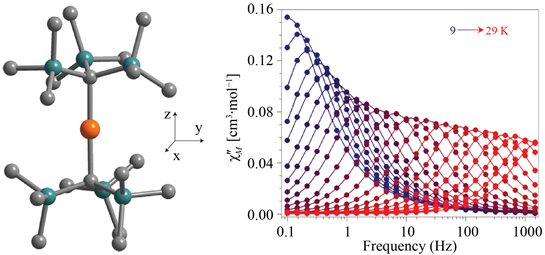 (a) (b)
(a) (b)
Figure 5. Structure of the [Fe(C(SiMe3)3)2]2 anion (a) and components of theac. magnetic susceptibility data collected for [K(crypt-222)][FeI(C(SiMe3)3)2] under a zero applied dc (b)
图5. [Fe(C(SiMe3)3)2]2阴离子的结构(a),在零外加直流电压下为[K(crypt-222)][FeI(C(SiMe3)3)2]收集的交流磁化率数据(b)
2012年Joseph M.等人制备了一系列Fe (II)二配位配合物 [16],其中配合物1:Fe[N(SiMe3)(Dipp)]2,配合物2:Fe[C(SiMe3)3]2,在Fe(II)中心均具有线性几何形状(图6),测试拟合得到的有效能垒分别为Ueff = 181 cm−1和Ueff = 146 cm−1,实验表明,二配位线型构型的配合物是较好的过渡单分子磁体。
 (a) (b)
(a) (b)
Figure 6. Structures of the complexes 1 (a) and 2 (b)
图6. 配合物1的结构(a),配合物2的结构(b)
此外研究者们还基于三价的Fe离子构筑了具有单分子磁体行为的配合物,S.Mossin团队在同年合成了[(PNP)FeCl2] (图7) [17],该配合物在80 K以上显示出S = 3/2到S = 5/2转变,在10~1042 Hz显示出前所未有的几乎完全线性的阿伦尼乌斯图,基态不是单纯的S = 3/2,而是一种量子力学混合态,通过自旋的作用使靠近的激发S = 5/2态混合−轨道耦合,使得Ueff = 32~36 cm−1,高于通过磁化率测量获得的参数D所得到的势垒(Ueff = 22 cm−1),弛豫时间τ0 = 6 × 10−9秒。
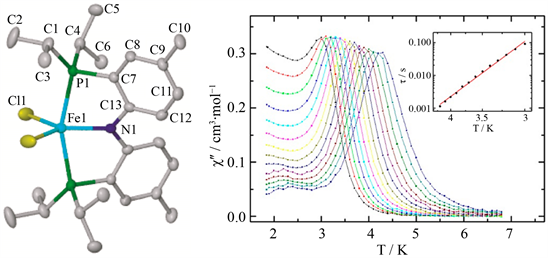 (a) (b)
(a) (b)
Figure 7. Molecular structure of complex [(PNP)FeCl2] (a) and Out-of-phase ac magnetic susceptibility of 1 in zerofield as a function of temperature at frequencies from 10 Hz (black) to1042 Hz (blue). Insert: Arrhenius plot and linear fit of the maxima (b)
图7. [(PNP)FeCl2]分子的结构图(a),和10~1042 Hz频率下,零场下[(PNP)FeCl2]配合物交流磁化率随温度变化曲线,插图:阿伦尼乌斯图和极大值的线性拟合图(b)
2.3. Co原子构筑的单分子磁体
Co原子在构筑单分子磁体的过程中扮演十分重要的角色,尤其是特别强调了分子形状、大小和对称性的影响。一价的Co离子报道较少,高松课题组在2015年合成了[Co(IMes)2][BPh4]配合物 [18] (图8),这种配合物在外加直流电场下表现出较大的室温磁矩和缓慢的磁弛豫行为,其Ueff = 21.3 cm−1,弛豫时间τ0 = 6.6 × 10−6 s,具有不同NHC配体Co(sIMes)2][BPh4]和[Co(IAd)2][BArF4]的模拟双配位钴配合物不显示这种单离子磁体行为。通过对这三种配合物结构的比较和从头计算表明两个NHC平面之间的二面角和NHC配体的不饱和度可以显著改变两个配位钴(I)-NHC离子的D值,D值主导着Co-NHC π相互作用的变化和进一步自旋–轨道耦合分裂的变化。同时二次金属–配体相互作用不同,被发现是非二次离子质谱。因此,二次金属–配体相互作用也被认为是磁动力学的一个重要变量。
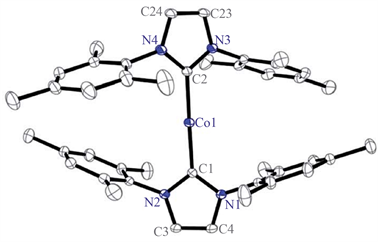
Figure 8. Structures of the cations [Co(IMes)2]+ of [Co(IMes)2][BPh4]
图8. 阳离子[Co(IMes)2]+的结构
二价的钴离子是过渡单分子磁体的一大家族,然而,它们通常给出相对较低的有效势垒,因为其中大多数具有与易平面各向异性相对应的正D值。通常认为,过渡金属单分子磁体的缓慢弛豫行为需要负D,直到Pardo的课题组报道了第一个八面体易面模型cis-[Co(dmphen)2(NCS)2] (dmphen = 2,9-dimethyl-1,10-phenanthroline) [19],其具有高度菱形扭曲的八面体环境,经直流磁测量、EPR和计算显示其较大的正D = +98 cm−1,E = +8.4 cm−1,能量势垒Ueff = 16.2~18.1 cm−1,对于该配合物,场诱导慢磁弛豫不是由D参数控制的轴向各向异性势垒引起的,而是由E参数控制的横向各向异性势垒引起的(图9)。这是具有横向各向异性势垒的单核六坐标Co(II)络合物中场诱导单分子磁体行为的第一个示例。
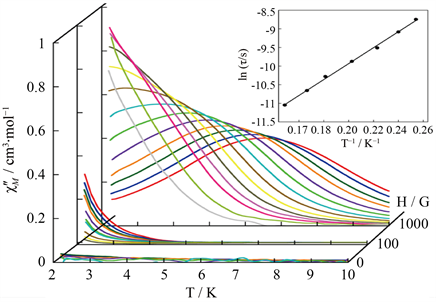
Figure 9. The Arrhenius plot in the high-temperature region under a staticapplied field of 1000 Oe
图9. 在1000Oe静态外加电场下高温区域的阿伦尼乌斯图
关于八面体构型的二价钴离子的报道还有很多,Palii等人合成了二价Co的配合物Et4N[Co(hfac)3] (hfac = hexafluoroacetylacetonate)其能垒达到14.3 cm−1 [20],几乎同一年S’witlicka-Olszewska报道了一个新的单核六配位的二价Co单分子磁体[Co(dca)2(bim)4]磁性研究显示能垒达到13.81 cm−1 [21] (图10)。此外,刘等人合成了一种新型的二维配位聚合物[Co(ppad)2]n [22],其能垒达到11.37 cm−1。王等人合成了三维手性配合物[Co(bmzbc)2(1,2-etdio)]n [23],能垒达到11.6 cm−1。一种新型的二价Co化合物{[Co(bmzbc)2]∙2DMF}n能垒为8.7 cm−1 [24]。研究表明,构型为八面体的二价Co的配合物能垒都不高。
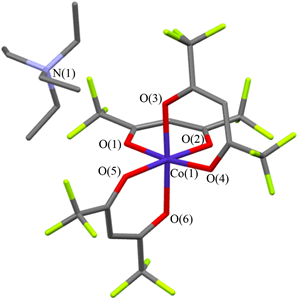 (a)
(a)
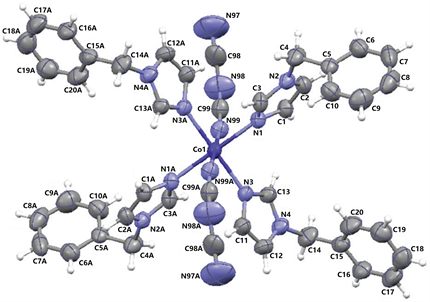 (b)
(b)
Figure 10. Crystal structure of compound Et4N[Co(hfac)3] (a) Perspective view of the metal environment in [Co(dca)2(bim)4] together with the atom numbering (b)
图10. 化合物Et4N[Co(hfac)3]的晶体结构(a) [Co(dca)2(bim)4]中金属环境的透视图以及原子编号(b)
与八面体构型不同的是,线性构型的二价钴离子是构筑单分子磁体的优秀候选者,2017年,高等人报道了三例二价钴合物 [25],[(IPr)CoNDmp] (1, Dmp = 2,6-dimesitylphenyl);[(cyIPr)CoNDmp] (2)和[(sIPr)CoNDmp] (3),磁性测试表明,在1.5 kOe的外加直流场下,配合物1的有效能垒为317 cm−1,配合物2为308 cm−1,而配合物3的能垒达到了413 cm−1 (图11),这打破了当时过渡金属单分子磁体有效能垒的记录。
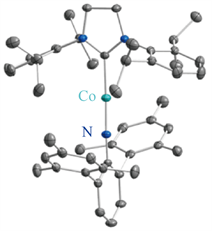
Figure 11. Molecular structure of complex 3
图11. 配合物3的分子结构
但在一年之后,J. R. Long课题组就在二价钴离子的化合物Co(C(SiMe2ONaph)3)2中将顺磁离子的轨道角动量提升到了极致 [26]。在该化合物中Co(II)的轨道角动量L = 3使得分子具有更大的磁各向异性,测试拟合得到的有效能垒为450 cm−1。创造了新的过渡单分子磁体有效能垒的记录(图12)。
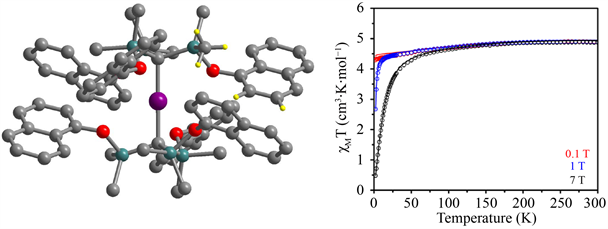 (a) (b)
(a) (b)
Figure 12. Molecular structure of Co(C(SiMe2ONaph)3)2. The purple, gray, turquoise, red and yellow spheres represent Co, C, Si, O and H atoms, respectively. Most of the hydrogen atoms have been omitted for clarity (a) and the variational temperature molar susceptibility collected under a DC field multiplied by the temperature plot (b)
图12. Co(C(SiMe2ONaph)3)2的分子结构,紫色、灰色、绿松石色、红色和黄色球体分别代表Co、C、Si、O和H原子。为了清楚起见,省略了大多数氢原子(a),不同直流场下的变温磁化率(b)
2.4. 其他原子构筑的单分子磁体
关于Ni原子构筑的单分子磁体较少,其中描述的涉及一价镍离子的单分子磁体行为的唯一示例是Poulten等在2013年报道的线性几何体[Ni(6-Mes)2]Br [27],密度泛函理论计算表明,五个被占据的金属基轨道以大约2:1:2的模式分裂。这种轨道简并导致了显著的磁各向异性,从而导致了单离子磁体(SIM)行为。其有效能垒为11.8 cm−1。
2015年,Jozef Miklovic等 [28] 首次报道了单核六配位Ni(II)络合物[Ni(pydc)(pydm)]∙H2O,该络合物具有很高的磁各向异性,其有效能垒Ueff = 14 cm−1。尽管有前景的研究表明,一些二价镍配合物具有非常大的磁各向异性 [29],但遗憾的是其并没有磁化缓慢弛豫行为。
2015年邓等人 [30] 报道了两种单核Cr(II)化合物[Cr(N(TMS)2)2(py)2] (1)和[Cr(N(TMS)2)2(THF)2] (2) (图13),这是在任何金属离子的方形平面配位几何中首次观察到的单分子磁体行为的例子。配合物1的有效能垒Ueff = 6.3 cm−1,配合物2的有效能垒Ueff = 8.2 cm−1。相关Cr原子的报道也很少,但Cr的同位素有50Cr,52Cr,54Cr,自然丰度高达90.5%,且没有核自旋,因此我们能够在不受任何超精细效应的影响下研究更纯净的单离子磁体,未来Cr(II)离子可能是一个很好的候选者。
 (a) (b)
(a) (b)
Figure 13. Molecular structures of 1 (a) and 2 (b)
图13. 分子结构配合物1 (a),配合物2 (b)
3. 结论与展望
单分子磁体从发现至今并没有很长的时间,作为一个新的研究领域,研究者发现其有很大的研究价值,进十年,过渡单分子磁体发展迅速,研究者们以增强磁各向异性和抑制量子隧穿效应为重点,合成了越来越多更高能垒的配合物。其中,二配位的线型有利于形成大的单轴磁各向异性,是高能垒单分子磁体的优秀构型。然而,有些配合物虽然具有非常大的磁各向异性,但其有效能垒很低甚至没有磁弛豫行为,因此,深入地理解影响有效能垒和慢磁弛豫的因素对于发展具有更好性能的单分子磁体极为重要。
目前,大部分高性能的磁体很不稳定,这很大程度上妨碍了它的应用,高稳定性的单分子磁体还有待研究。且过渡金属单分子磁体的能垒远小于稀土单分子磁体,因此,研究合成4d、5d的过渡单分子磁体很有必要。4d、5d过渡金属较3d有大的自旋–轨道耦合参数和较高的磁各向异性。高度各向异性的自旋–自旋耦合与大交换参数相结合,是多核磁性配合物整体磁各向异性的一个非常重要的来源,即使几百个波数,磁性团簇的U值也可能变得相当大。但如果要在开发可靠模型方面取得进展,则需要打下更多的基础。
基金项目
江苏省高校自然科学研究基金(NO. 19KJB430030)和南通市科技项目(NO. JC2020130, JC2020133, JC2020134)资助。
文章引用
薛 泓,丁欣宇. 过渡单分子磁体的研究进展
Recent Advanced of Transition Single-Molecule Magnets[J]. 物理化学进展, 2022, 11(04): 185-195. https://doi.org/10.12677/JAPC.2022.114021
参考文献
- 1. Sessoli, R., Gatteschi, D., Caneschi, A. and Novak, M.A. (1993) Magnetic Bistability in a Metal-Ion Cluster. Nature, 365, 141-143. https://doi.org/10.1038/365141a0
- 2. Yoo, J.W., Chen, C.Y., Jang, H.W., Bark, C.W., Prigodin, V.N., Eom, C.B. and Epstein, A.J. (2010) Spin Injection/Detection Using an Organic-Based Magnetic Semiconductor. Nature Materials, 9, 638-642. https://doi.org/10.1038/nmat2797
- 3. Shao, D. and Wang, X.Y. (2020) Development of Single Molecule Magnets. Chinese Journal of Chemistry, 38, 1005-1018. https://doi.org/10.1002/cjoc.202000090
- 4. Mannini, M., Pineider, F., Sainctavit, P., Danieli, C., Otero, E., Sciancalepore, C., Talarico, A.M., Arrio, M.A., Cornia, A., Gatteschi, D. and Sessoli, R. (2009) Magnetic Memory of a Single-Molecule Quantum Magnet Wired to a Gold Surface. Nature Materials, 8, 194-197. https://doi.org/10.1038/nmat2374
- 5. Sessoli, R. and Powell, A.K. (2009) Strategies towards Single Molecule Magnets Based on Lanthanide Ions. Coordination Chemistry Reviews, 253, 2328-2341. https://doi.org/10.1016/j.ccr.2008.12.014
- 6. Wernsdorfer, W., Aliaga-Alcalde, N., Hendrickson, D.N. and Christou, G. (2002) Exchange-Biased Quantum Tunnelling in a supramolecular Dimer of Single-Molecule Magnets. Nature, 416, 406-409. https://doi.org/10.1038/416406a
- 7. Habib, F., Long, J., Lin, P.-H., Korobkov, I., Ungur, L., Wernsdorfer, W., Chibotaru, L.F. and Murugesu, M. (2012) Supramolecular Architectures for Controlling Slow Magnetic Relaxation in Field-Induced Single-Molecule Magnets. Chemical Science, 3, 2158-2164. https://doi.org/10.1039/c2sc01029a
- 8. Murugesu, M., Habrych, M., Wernsdorfer, W., Abboud, K.A. and Christou, G. (2004) Single-Molecule Magnets: A Mn25 Complex with a Record S = 51/2 Spin for a Molecular Species. Journal of the American Chemical Society, 126, 4766-4767. https://doi.org/10.1021/ja0316824
- 9. Murugesu, M., Takahashi, S., Wilson, A., Abboud, K.A., Wernsdorfer, W., Hill, S. and Christou, G. (2008) Large Mn25 Single-Molecule Magnet with Spin S = 51/2: Magnetic and High-Frequency Electron Paramagnetic Resonance Spectroscopic Characterization of a Giant Spin State. Inorganic Chemistry, 47, 9459-9470. https://doi.org/10.1021/ic801142p
- 10. Tasiopoulos, A.J., Vinslava, A., Wernsdorfer, W., Abboud, K.A. and Christou, G. (2004) Giant Single-Molecule Magnets: A [Mn84] Torus and Its Supramolecular Nanotubes. Angewandte Chemie International Edition, 43, 2117-2121. https://doi.org/10.1002/anie.200353352
- 11. Milios, C.J., Vinslava, A., Wernsdorfer, W., Moggach, S., Parsons, S., Perlepes, S.P., Christou, G. and Brechin, E.K. (2007) A Record Anisotropy Barrier for a Single-Molecule Magnet. Journal of the American Chemical Society, 129, 2754-2755. https://doi.org/10.1021/ja068961m
- 12. Neese, F. and Pantazis, D.A. (2011) What Is Not Required to Make a Single Molecule Magnet. Faraday Discussions, 148, 229-238. https://doi.org/10.1039/C005256F
- 13. Ruiz, E., Cirera, J., Cano, J., Alvarez, S., Loose, C. and Kortus, J. (2008) Can Large Magnetic Anisotropy and High Spin Really Coexist? Chemical Communications, No. 1, 52-54. https://doi.org/10.1039/B714715E
- 14. Freedman, D.E., Harman, W.H., Harris, T.D., Long, G.J., Chang, C.J. and Long, J.R. (2010) Slow Magnetic Relaxation in a High-Spin Iron(II) Complex. Journal of the American Chemical Society, 132, 1224-1225. https://doi.org/10.1021/ja909560d
- 15. Zadrozny, J.M., Xiao, D.J., Atanasov, M., Long, G.J., Grandjean, F., Neese, F. and Long, J.R. (2013) Magnetic Blocking in a Linear Iron(I) Complex. Nature Chemistry, 5, 577-581. https://doi.org/10.1038/nchem.1630
- 16. Zadrozny, J.M., Atanasov, M., Bryan, A.M., Lin, C.-Y., Rekken, B.D., Power, P.P., Neese, F. and Long, J.R. (2013) Slow Magnetization Dynamics in a Series of Two-Coordinate Iron(ii) Complexes. Chemical Science, 4, 125-138. https://doi.org/10.1039/C2SC20801F
- 17. Mossin, S., Tran, B.L., Adhikari, D., Pink, M., Heinemann, F.W., Sutter, J., Szilagyi, R.K., Meyer, K. and Mindiola, D.J. (2012) A Mononuclear Fe(III) Single Molecule Magnet with a 3/2↔5/2 Spin Crossover. Journal of the American Chemical Society, 134, 13651-13661. https://doi.org/10.1021/ja302660k
- 18. Meng, Y.S., Mo, Z., Wang, B.W., Zhang, Y.Q., Deng, L. and Gao, S. (2015) Observation of the Single-Ion Magnet Behavior of d8 Ions on Two-Coordinate Co(I)-NHC Complexes. Chemical Science, 6, 7156-7162. https://doi.org/10.1039/C5SC02611C
- 19. Vallejo, J., Castro, I., Ruiz-Garcia, R., Cano, J., Julve, M., Lloret, F., De Munno, G., Wernsdorfer, W. and Pardo, E. (2012) Field-Induced Slow Magnetic Relaxation in a Six-Coordinate Mononuclear Cobalt(II) Complex with a Positive Anisotropy. Journal of the American Chemical Society, 134, 15704-15707. https://doi.org/10.1021/ja3075314
- 20. Palii, A.V., Korchagin, D.V., Yureva, E.A., Akimov, A.V., Misochko, E.Y., Shilov, G.V., Talantsev, A.D., Morgunov, R.B., Aldoshin, S.M. and Tsukerblat, B.S. (2016) Single-Ion Magnet Et4N[CoII(hfac)3] with Nonuniaxial Anisotropy: Synthesis, Experimental Characterization, and Theoretical Modeling. Inorganic Chemistry, 55, 9696-9706. https://doi.org/10.1021/acs.inorgchem.6b01473
- 21. Switlicka-Olszewska, A., Palion-Gazda, J., Klemens, T., Machura, B., Vallejo, J., Cano, J., Lloret, F. and Julve, M. (2016) Single-Ion Magnet Behaviour in Mononuclear and Two-Dimensional Dicyanamide-Containing Cobalt(II) Complexes. Dalton Transactions, 45, 10181-10193. https://doi.org/10.1039/C6DT01160H
- 22. Liu, X., Sun, L., Zhou, H., Cen, P., Jin, X., Xie, G., Chen, S. and Hu, Q. (2015) Single-Ion-Magnet Behavior in a Two-Dimensional Coordination Polymer Constructed from CoII Nodes and a Pyridylhydrazone Derivative. Inorganic Chemistry, 54, 8884-8886. https://doi.org/10.1021/acs.inorgchem.5b01651
- 23. Wang, Y.L., Chen, L., Liu, C.M., Du, Z.Y., Chen, L.L. and Liu, Q.Y. (2016) 3D Chiral and 2D Achiral Cobalt(II) Compounds Constructed from a 4-(benzimidazole-1-yl)benzoic Ligand Exhibiting Field-Induced Single-Ion-Magnet-Type Slow Magnetic Relaxation. Dalton Transactions, 45, 7768-7775. https://doi.org/10.1039/C6DT00676K
- 24. Wang, Y.L., Chen, L., Liu, C.M., Zhang, Y.Q., Yin, S.G. and Liu, Q.Y. (2015) Field-Induced Slow Magnetic Relaxation and Gas Adsorption Properties of a Bifunctional Cobalt(II) Compound. Inorganic Chemistry, 54, 11362-11368. https://doi.org/10.1021/acs.inorgchem.5b02324
- 25. Yao, X.N., Du, J.Z., Zhang, Y.Q., Leng, X.B., Yang, M.W., Jiang, S.D., Wang, Z.X., Ouyang, Z.W., Deng, L., Wang, B.W. and Gao, S. (2017) Two-Coordinate Co(II) Imido Complexes as Outstanding Single-Molecule Magnets. Journal of the American Chemical Society, 139, 373-380. https://doi.org/10.1021/jacs.6b11043
- 26. Bunting, P.C., Atanasov, M., Damgaard-Moller, E., Perfetti, M., Crassee, I., Orlita, M., Overgaard, J., van Slageren, J., Neese, F. and Long, J.R. (2018) A Linear Cobalt(II) Complex with Maximal Orbital Angular Momentum from a Non-Aufbau Ground State. Science, 362, eaat7319. https://doi.org/10.1126/science.aat7319
- 27. Poulten, R.C., Page, M.J., Algarra, A.G., Le Roy, J.J., Lopez, I., Carter, E., Llobet, A., Macgregor, S.A., Mahon, M.F., Murphy, D.M., Murugesu, M. and Whittlesey, M.K. (2013) Synthesis, Electronic Structure, and Magnetism of [Ni(6-Mes)2] +: A Two-Coordinate Nickel(I) Complex Stabilized by Bulky N-Heterocyclic Carbenes. Journal of the American Chemical Society, 135, 13640-13643. https://doi.org/10.1021/ja407004y
- 28. Miklovic, J., Valigura, D., Boca, R. and Titis, J. (2015) A Mononuclear Ni(II) Complex: A Field Induced Single-Molecule Magnet Showing Two Slow Relaxation Processes. Dalton Transactions, 44, 12484-12487. https://doi.org/10.1039/C5DT01213A
- 29. Ruamps, R., Maurice, R., Batchelor, L., Boggio-Pasqua, M., Guillot, R., Barra, A.L., Liu, J., Bendeifel, E., Pillet, S., Hill, S., Mallah, T. and Guihery, N. (2013) Giant Ising-Type Magnetic Anisotropy in Trigonal Bipyramidal Ni(II) Complexes: Experiment and Theory. Journal of the American Chemical Society, 135, 3017-3026. https://doi.org/10.1021/ja308146e
- 30. Deng, Y.F., Han, T., Wang, Z., Ouyang, Z., Yin, B., Zheng, Z., Krzystek, J. and Zheng, Y.Z. (2015) Uniaxial Magnetic Anisotropy of Square-Planar Chromium(II) Complexes Revealed by Magnetic and HF-EPR Studies. Chemical Communications, 51, 17688-17691. https://doi.org/10.1039/C5CC07025B
NOTES
*通讯作者。